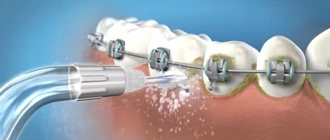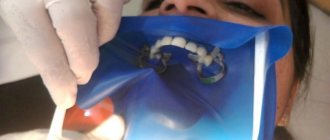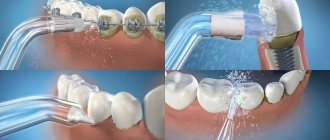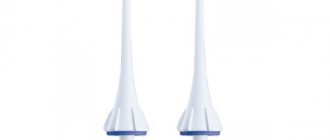Good oral hygiene is extremely important not only to maintain an aesthetically attractive appearance, but also to maintain the healthy functioning of the body as a whole. Currently, there are many functionally useful devices for hygienic treatment of the oral cavity. One such device is an irrigator.
In this article we will try to tell you in detail about how to properly use an irrigator to clean your teeth and how often you can use an oral irrigator .
Why do you need an irrigator and how does it work?
An irrigator is essentially a device that treats the oral cavity using a focused jet of water supplied under high pressure. The enhancing effect is the pulsating mode of liquid supply. As a result of this treatment, full-scale removal of contaminants occurs both from the surface of the teeth and gums, and from the interdental spaces.
In connection with the popularization of irrigators, consumers have a number of questions, the most pressing of which are: how to properly use an irrigator for cleaning teeth and how often can you use a dental irrigator ?
At what age can children use an irrigator? In order to answer these and many other questions related to the use of this relatively new device for us, it is necessary to consider in more detail some of the nuances.
How does an oral irrigator work?
The operating principle of an oral irrigator is quite simple. Structurally, the device consists of several parts:
- a water tank or a special antiseptic solution;
- a power unit that powers the device;
- a small water pump that increases fluid pressure;
- outlet nozzle through which the solution is delivered to the mouth.
When the device is turned on, liquid from the reservoir passes into the internal system of the device through a special pipe and flows to the tip. Most devices support stepwise or smooth adjustment of the flow pressure, and can also supply a regular, pulsating or microbubble-saturated jet. When the liquid gets on the teeth, it washes away plaque and food particles, and also provides a massage to the soft tissues.
Attention! The most convenient to use are irrigators with special attachments for orthodontic structures, tongue and gums. They are universal and take care of the entire oral cavity.
Indications for use of the irrigator
- Prevention of caries. Due to the fact that the effect of the irrigator extends to the most inaccessible areas of the oral cavity, it becomes a good prevention of many dental diseases, the main and most common of which is caries. The irrigator is able to clean both the surface of the front teeth and wisdom teeth, which are the most inaccessible, and therefore are recognized as the most vulnerable dental units;
- Prevention of gum disease. A focused and dense stream supplied by the irrigator has a massaging effect on the surface of the gums, which in turn serves as a good prevention of many diseases, including bleeding;
- Care of implantation, prosthetics and braces systems. The irrigator is capable of efficiently and quickly processing both the surface of prosthetic elements and the cavities hidden behind them;
- Prevention of gingivitis. A massaging jet of water stimulates and restores impaired blood supply to soft tissues. This procedure is most relevant for pregnant women who have the greatest tendency to develop this disease;
- Prevention of unpleasant odor. The irrigator efficiently washes away food debris, which is a source of unpleasant odor, even from the most inaccessible areas of the oral cavity;
- A history of nasopharyngeal diseases. This direction is an additional option and requires special nozzles suitable for rinsing the nasal passages. Such treatment is carried out only on the recommendation of an otolaryngologist.
Why do you need an irrigator?
The irrigator increases the effectiveness of oral hygiene procedures and prevents dental diseases:
- Using a jet of water under pressure, it more effectively removes food debris and bacteria from hard-to-reach places:
- between teeth
- from gum pockets,
- from under crowns and braces.
- Effectively removes plaque and bacteria from the tongue.
- By massaging the gums, it improves blood circulation in them, and therefore nutrition of the teeth.
- Polishes tooth enamel.
Contraindications to using an irrigator
There are literally no such contraindications. There are some restrictions on the use of this device.
Limitations of using the irrigator:
- Children under six years of age;
- Excessively developed gag reflex;
- Diseases of the oral cavity during exacerbation;
- Postoperative conditions;
- A history of serious neurological and cardiovascular diseases;
- increased sensitivity of teeth and bleeding gums.
Contraindications for use of the device
In addition to the enormous benefits, the presented device has contraindications:
- postoperative period of dental surgery;
- stage of exacerbation of gum disease;
- recovery period after installation of braces or implants;
- diseases of the cardiovascular system, which lead to bleeding gums due to damage to blood vessels;
- period of course treatment of dental diseases.
Cleaning the bracket system
It is not recommended to use the irrigator for children under 6 years of age, as well as for those people who have previously experienced prolonged bleeding of the gums.
Types of irrigators
- Stationary. The jet power of such an irrigator should not be less than 550 kPa. The stationary mounting device has a softer and more comfortable system for switching modes, which is an undeniable advantage if the users include children, the elderly and people with disabilities. The optimal level of jet pulsation corresponds to 1200 pulsations. The device is mounted on a horizontal surface. A relative disadvantage of the installation can be considered its rather large dimensions. In this regard, stationary irrigators are installed in the bathroom. Power is supplied from the electrical network. A distinctive feature is the large volume of the liquid reservoir, a powerful motor and the creation of high pressure when supplying liquid.
- Portable irrigators. The advantage of such irrigators is their complete autonomy due to the ability to operate on a battery, which allows you to take the device with you on trips. The power ratings of a portable device should not be less than 520 kPa. Changing operating modes occurs in a stepwise manner.
- Flow irrigators. The simplest device installed directly on the water tap. The force of the jet is regulated by the mixer valves.
- Mechanical irrigators. Water pressure is created by pumping by pressing the built-in piston.
In addition to the installation method, irrigators differ in the type of jet supplied.
What characteristics of irrigators are important?
Before purchasing, you need to decide on the following points:
- dimensions and weight of the device. The larger the tank, the larger the irrigator. The principle of operation does not depend on size, but compact models usually have lower power ratings;
- the ability to move the device - portable irrigators are easy to take with you anywhere, without being dependent on the presence of an outlet;
- desired functions of the irrigator - devices with low power (approximately 500 kPa) are suitable for everyday care, and if you have oral diseases, it is worth considering models with higher power;
- types of nozzles - their number can be in the dozens. There are attachments for the tongue, gums, braces, etc., so you need to decide what you need;
- how many people will use the device. Perhaps for home it makes sense to purchase a powerful stationary irrigator with a set of attachments, and for travel, purchase a small portable device powered by a battery.
Does every family member need an irrigator? Children from 5-6 years old can use the device in the same way as adults (of course, the operating rules should be explained in advance). Baby teeth are even more sensitive to caries than permanent teeth.
The use of an irrigator is especially important for:
- those who have installed braces, veneers, crowns, implants - the use of this device greatly facilitates the care of orthodontic systems;
- pregnant women, since during pregnancy especially careful oral hygiene is required in order to prevent the formation of inflammation, tartar, caries, and periodontal diseases; suffering from periodontal diseases in the early stages;
- patients with hormonal disorders.
Types of irrigators by type of jet supplied
- Monojet. They represent a continuously supplied flow having the same power and direction;
- Turbo flow with pulsation. The most modern technology, characterized by the supply of micro-hydro-impact jets that target specific areas.
The optimal level of jet frequency is considered to be 1200 pulsations per minute. Some models allow you to reproduce frequencies in excess of 1700 beats.
The classic volume of the reservoir, designed for one session (one cleaning) is 150-200 ml of water for portable and 500 ml more for stationary irrigators. The correct selection of the cleaning attachment plays an important role.
Which nozzle to choose for using an irrigator
There are several different attachments for the irrigator, the choice of each of which depends on the required purposes:
- Standard. Designed for treating teeth and gums without signs of disease.
- Orthodontic. It will be the best option for people using any type of prosthetic systems. This attachment allows you to remove plaque and dirt under bracket systems and bridge retainers with the highest quality possible.
- Periodontal attachment. It is considered a highly targeted accessory. It is used only at minimum power levels and is necessary for cleaning interdental spaces.
- Implantation attachment. As the name suggests, it is used in cases when it comes to the need for hygiene of teeth with implants and crowns. A distinctive feature is the presence of 3 tufts of bristles on the tip.
- Tongue treatment attachment.
- Brush type nozzle. It should be noted that such an attachment cannot act as an absolute substitute for a toothbrush.
We should also highlight the additional function of the irrigator. The essence of this direction is preventive measures in the treatment of sinusitis and rhinitis. In this case, a specialized nozzle and an individually selected mode are used.
What liquid to pour into the irrigator
To refill the device, liquids are used, which, depending on the composition, have one or another effect.
Main types of compositions:
- Fluoridating. Aimed at strengthening tooth enamel;
- Therapeutic and prophylactic. Contain antiseptic additives, mostly of plant origin;
- Refreshing. The composition of such liquids includes menthol and eucalyptus, which help freshen breath;
- Antiperiodontal. Contains various biooxidants and anti-caries components;
- Hypoallergenic. They have a neutral composition, suitable for people prone to allergic reactions.
The most popular balms for irrigator
“Terasol” (antimicrobial effect), “Denfil” (alcohol-free balm, acceptable for use in children), “Asepta” (caries prevention), “Irix” (non-foaming balm with menthol to freshen breath).
The use of tap water is extremely undesirable due to the risk of device failure, since this water contains sedimentary components.
If it is impossible to use balsamic liquids, you can use boiled or special purified water.
Which dental irrigator to choose
Basically, irrigators are divided into 2 types: stationary and mobile. Stationary irrigators have a large capacity for liquid (about 1000 ml), operate from the mains and their main distinguishing feature is high power. Mobile (portable) irrigators are light in weight, the volume of liquid is almost 2 times less than that of stationary ones (400-500 ml) and operate on batteries.
If you plan to mainly use the irrigator at home, then it is certainly better to buy a stationary irrigator, since you do not need to buy batteries for it, and the large volume of the liquid reservoir is enough for several uses, or for use by two people.
If you travel often, it is better to take a portable irrigator model, since it takes up little space and does not require an outlet to operate.
How are irrigators different?
- Pressure.
The more pressure, the better for hygiene. However, strong pressure can cause discomfort during use or even damage your gums. Therefore, it is better for beginners to use irrigators with power adjustment.
- Special settings.
Pulsating or microbubble technology is recommended for patients with gum disease, as well as those undergoing orthodontic treatment.
- Number of nozzles.
The set includes many attachments: standard, for cleaning teeth, tongue, periodontal pockets, braces, veneers and other structures.
- Volume.
The reservoir, which is filled with water and medicinal solution, must be sufficient for the procedure. The main disadvantage of portable devices is the small volume of the tank and sometimes you have to stop to refill it. Stationary irrigators do not have this disadvantage.
- Battery capacity.
This characteristic applies only to portable devices. And the larger the capacity, the better.
If the whole family plans to use the irrigator, you should choose a stationary one that has many attachments and a large reservoir for liquid. If you only need to improve hygiene indicators, then you can choose a mono-jet device. If there is a need for extended use, it is better to use multi-jet.
How often can and should you use an irrigator?
In order to understand how many times a day you can use the irrigator, you need to determine the ultimate purpose of using the device. So, for normal oral hygiene, you can use the irrigator once a day, or every other day. The use of specialized balms for prophylactic purposes is allowed no more than 2-3 times a week.
Excessively frequent use of an irrigator can lead to the opposite consequences, namely, thinning of the enamel layer and expansion of gum pockets in areas of periodontitis.
How to properly care for your irrigator?
The device must be washed 1-2 times a month when using water and every week when using solutions. The attachments should be washed at the same frequency or more often, if possible changing them after 3-4 months. Washing is carried out with warm boiled water. You can use a sponge to clean dirty parts. The set of some irrigator models includes a special sterilizer for thoroughly cleaning the nozzles. A irrigator connected to a water supply may accumulate sediment. To remove it, special liquid products for cleaning irrigators are used.
How to use an irrigator: step-by-step instructions
The essence of the action of irrigators is mostly identical. Below are detailed instructions on how to use the irrigator :
- It is necessary to consult a dentist to select the optimal mode of operation of the irrigator, the type of nozzle and the liquid used.
- It is advisable to use an irrigator after using a toothbrush and dental floss.
- You need to choose the most suitable mode. Experts usually recommend starting to get acquainted with the device with minimal power, gradually increasing it as you get used to it. On average, the adaptation period lasts about 7 days.
- The nozzle of the nozzle is directed so that the supplied jet is perpendicular to the surface of the teeth and gums.
- Each dental unit is treated on all sides and adjacent areas of the gums.
- If a special liquid was used that included additional additives, the mouth must be rinsed with water immediately after completing the procedure.
Additional recommendations for using the irrigator:
- The optimal time to use the irrigator is in the evening;
- The average time required for high-quality cleaning of the entire oral cavity is about 10 minutes;
- People with prosthetic structures are advised to use an irrigator after each meal;
- It is not recommended to use an irrigator immediately after flossing (if the gums have been injured by it.) This is due to the risk of additional injury to the gums;
- During the procedure, the tongue is pressed against the upper palate to prevent fluid from entering the respiratory tract;
- Processing is carried out smoothly, avoiding sudden movements. If unpleasant sensations occur, the power of the jet is reduced.
How to clean the waterpik after use
After each use of the irrigator to clean your teeth, you must pour out the remaining liquid from the reservoir so that bacteria and germs do not accumulate there. After cleaning, you need to unplug the device, remove the nozzle and pour the remaining liquid from the reservoir. Next, you need to thoroughly rinse and dry the irrigator; the nozzle should be washed with soap and water and wiped thoroughly with a napkin. It is better to rinse the irrigator under warm water, as hot water can damage the body of the device.
How to use it correctly
Regardless of the type of liquid, the rules for its use should be strictly followed:
- If you use household products, you should carefully study their operating instructions.
- Do not use the liquid if there are contraindications and there are no indications for use.
- The use of homemade solutions is permissible after complete dissolution of all components in them and filtration of herbal decoctions.
- Most of these liquids are presented in the form of concentrates, requiring their preliminary dilution in a ratio of 1:10.
- To prepare liquids, you must use only purified, distilled or boiled water.
- The water temperature should not be more than 38 degrees.
- The most appropriate time for irrigation is the evening after brushing your teeth.
- The liquid is directed to the gums at an angle of 80 degrees, and the duration of the procedure should not exceed 15 minutes.
- The frequency of use of a particular liquid is determined taking into account its type and purpose.
Can two people use an irrigator?
When answering the question whether it is possible to use the irrigator together , it is important to mention that the device itself is designed for use by all family members. Only the nozzles themselves are individual. Just like a toothbrush, they are a means of personal hygiene. In this regard, when purchasing an irrigator, you need to pay attention to the number of nozzles included in the package and, if necessary, purchase the missing ones.
Nozzles should be replaced at least every 3-6 months.
How to use an irrigator: summary
If you follow all the rules and recommendations, the irrigator can become an indispensable hygiene product for the whole family. Its massaging and washing properties can help, if not eradicate, then minimize many problems associated with the condition of the oral cavity.
In this article, we tried to answer your question: how to properly use an irrigator to clean your teeth and mouth . In order for the use of an irrigator to bring maximum benefit, it would be advisable to consult a dentist.
How to choose a liquid for an irrigator?
When using the irrigator, special attention should be paid to the cleaning agent. Usually, irrigators come with a special balm that should be added to the water in the tank. The type of balm and the level of its concentration in water will depend on the condition of the oral cavity and the presence of certain dental problems. Some people pour regular rinse aids into the tank, but they foam quite a lot and make the cleaning process difficult. You can also use ordinary water as a cleaning agent, but only filtered water - it is safer and does not contain impurities that settle inside the device and interfere with its operation. Remember: if there is no water in the container, the irrigator cannot be turned on.
It is important to remember that it is not enough to buy an irrigator and think that it will save you from using conventional hygiene products! The device will provide a final cleaning of your teeth, removing what the toothbrush couldn’t handle. And the supplement will improve blood circulation, stimulate the renewal of soft tissues, prevent the formation of tartar and eliminate bad breath. Our Irrigator Rating 2022 will help you choose the right model.










